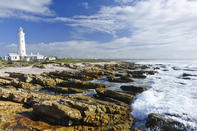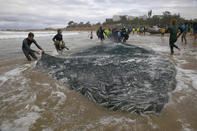Natural Migration of the Sardines
Every year, between the months of June and July, something spectacular occurs in our oceans. Sardines make their way up our coast in various large schools from the Western Cape before disappearing into the deep close to Durban in a spectacular occurrence known worldwide as the Sardine Run. The Sardine Run can be divided into three stages.

The first stage begins in the Port Elizabeth area, where the sardines come off the Agulhas banks. Because the banks are very deep, it is almost impossible to see them while diving and the sardines do not often venture close to the surface. The second stage is the best one for experiencing the natural migration of the sardines and diving with them and their predators. This stage takes place in the former Transkei – now the Eastern Cape.
The continental shelf is very close to land and the waters close to shore are very deep, making it easy for predators to trap the sardines and bring them up to the surface. Here you could get the chance to dive with the dolphins, sharks, whales and birds feasting on these bait balls.
While spending the day on the boat looking for the pockets of sardines, you will more than likely see a number of dolphins, including the Bottlenose, Common, Humpback, Spinner and Spotted varieties. An assortment of birds will also join you in looking for the sardines. A sure-fire sign that you have found the location of a sardine bait ball is the prevalence of Cape gannets. These birds will fold their wings back like F16 fighter planes before diving into the water after the sardines. This is a sign for you to get ready to enter the water.
Under the Water

Once your head is under the water, you will find yourself immersed amongst thousands of sardines, with countless dolphins and sharks feasting on them. The dolphins start their attack from the bottom, pushing the sardines up with their bubbles and noise. In between the birds swimming past you at around 10 metres, you will find sharks attacking the sardines, swimming straight through them to take bites out of the pocket.
As soon as the sardines split, the birds attack again from the top and the dolphins from the side. Not many sardines can survive this attack, and, when the last one in the bait ball is gone, the action moves on to the next ball. You may also be lucky enough to see migrating Humpback whales, although they are not part of the feeding frenzy. If you are really lucky, you could see a Brutus or Minke whale taking a big bite out of the bait ball. Southern right whales and Pilot whales are also commonly seen in the ocean while driving from one dive site to another.
The third and final stage of the Sardine Run occurs in the area between the old Transkei and Durban where the sardines get trapped in the shallow waters and can be found in the surf or just beyond the back line. During this stage the sardines often wash up on the beach and the conditions are not usually good for diving.
After swimming all this way, the sardines that survive will then return to deep waters. If you have not experienced it, it is almost impossible to describe what happens on the Sardine Run. This yearly experience is unique to Southern Africa and if you have any interest in diving whatsoever, you have to dive the Sardine Run at least once.
By Johan Boshoff